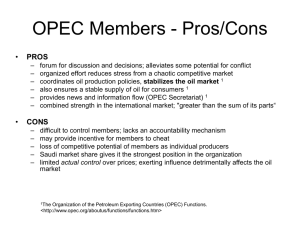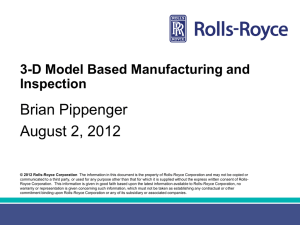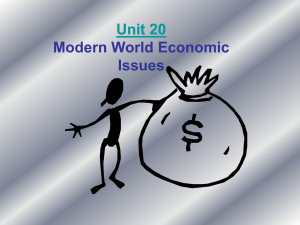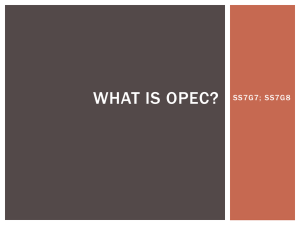mbd - United States Association for Energy Economics
advertisement
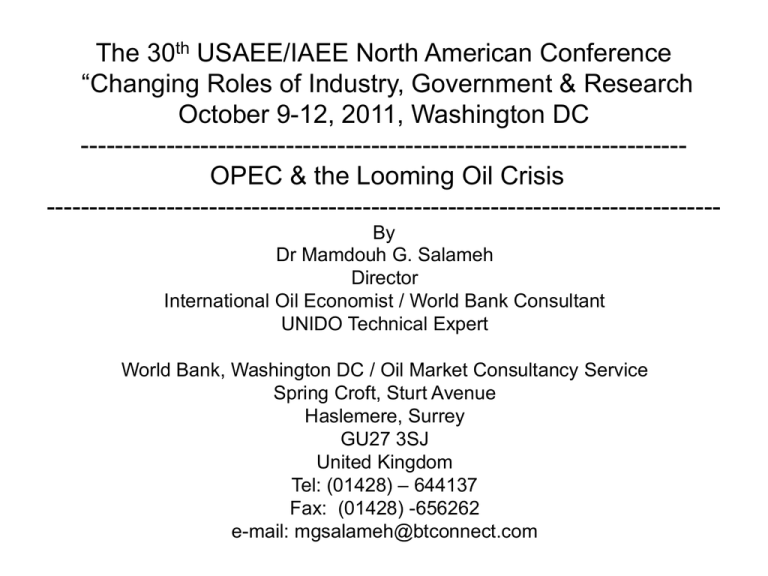
The 30th USAEE/IAEE North American Conference “Changing Roles of Industry, Government & Research October 9-12, 2011, Washington DC ----------------------------------------------------------------------OPEC & the Looming Oil Crisis ------------------------------------------------------------------------------By Dr Mamdouh G. Salameh Director International Oil Economist / World Bank Consultant UNIDO Technical Expert World Bank, Washington DC / Oil Market Consultancy Service Spring Croft, Sturt Avenue Haslemere, Surrey GU27 3SJ United Kingdom Tel: (01428) – 644137 Fax: (01428) -656262 e-mail: mgsalameh@btconnect.com Outline ------------------------• • • • • • • The Changing Global Oil Market Fundamentals Has OPEC Become Irrelevant? The Interplay between Oil & Geopolitics The China Factor Impact & Trends in the Global Economy An Impending Oil Crunch? Conclusions Introduction ------------------------------------------------------------ • The global oil market is at a crossroads. Current global trends in oil supply and demand are patently unsustainable environmentally, economically and socially. It is no exaggeration to claim that the future of global economic growth and, indeed, the future of human prosperity depend on how successfully we handle the two central challenges facing us today: oil supply security and the pace at which we develop alternatives to oil. • The oil market fundamentals have been undergoing drastic changes since the early 1990s. Unfortunately, the current alignment of these fundamentals could only lead to a severe tightening of the oil market. Other major factors impacting on the global oil market are China and the declining influence of OPEC • And with a looming oil crisis, OPEC will soon reach a crossroads. It has to ramp up supplies very significantly to stem the projected steep rise in the oil price or risk becoming irrelevant. However, OPEC’s previous encounter with high oil prices in 2008 does not inspire confidence. OPEC was then completely unable to halt the oil price onslaught because they hardly had any spare production capacity. • The pressure on the oil price will, therefore, continue unabated in coming years. Has OPEC Become Irrelevant? ------------------------------------------------------------------------------• The influence of OPEC has closely followed the peaks and valleys of the world's demand for oil. September 14, 2011 marked the group's fifty-first anniversary — a half-century of existence characterized by embargo, conflict, and even war. • Today, economists and analysts debate as to whether OPEC still has any influence on the global oil market and prices or has become irrelevant. • OPEC has not offset the loss of Libyan oil exports since February this year despite a surge in crude oil prices. OPEC production in the first half of 2011 averaged 28.8 mbd, down by nearly 1.4 mbd from February 2011. The drop took OPEC production to its lowest in almost two years despite concerns over the impact of high oil on the world economic recovery. • Yet against a background of rising oil prices, declining OPEC production and loss of Libyan oil exports, OPEC still wants us to believe that the market is well balanced with supplies meeting demand. The truth of the matter is that OPEC hardly has any spare capacity. • Conventional wisdom holds that OPEC has the world in its grasp. It can manipulate prices by tinkering with supplies. But the conventional wisdom is mostly wrong. OPEC is no wizard. For the most part, its actions lagged behind fundamental changes in oil supply and demand rather than led them. OPEC looks like a masterful cartel when, in fact, it is mainly just riding the waves. OPEC (Continued) -----------------------------------------------------------------------• Today’s oil cartel, even more than in the past, is really about Saudi Arabia. But Saudi Arabia also is no wizard at the controls of the world market. • The Saudis claim they have an ambitious plan to increase output by about one third over the coming decade, but they are finding that it will be a stretch. Their fellow OPEC members are in a similar situation. In fact, the Gulf members of OPEC are today producing at just the same level as they were three decades ago because none of them has invested enough in finding and producing new supplies. Those hard facts produce high oil prices. • In theory, one would assume that OPEC works more effectively when the oil prices slide down because it is within their power to cut production to shore up prices. But since the OPEC members have a history of not adhering to their reduced quotas, even this policy will eventually fail. Moreover, since the oil prices are projected to remain high well into the future, OPEC could become irrelevant and its production quota system redundant along with OPEC itself. The Changing Global Oil Market Fundamentals ----------------------------------------------------------12234- Peaking of conventional oil production Questionable proven oil reserves A slowdown in oil production & a growing supply/demand deficit A declining discovery rate A tight global production capacity Peaking of Conventional Oil Production ---------------------------------------------------------- • Conventional oil production peaked in 2006. Moreover, nine of the top oil producers in the world have already peaked (see Table 1). The only one among the top producers that has clear capability to increase production is Iraq once stability is restored to the country. Table 1 The Peak & Depletion of Conventional Crude Oil --------------------------------------------------------------------------------------------------------------------Country Date of Peak Discovery Date of Peak Production % Discovered % Depleted Ultimate Production (bb) --------------------------------------------------------------------------------------------------------------------Canada 1950s 1973 95 76 25 Iran 1960s 1974 94 76 130 Indonesia 1950s 1977 93 65 31 Mexico 1950s 2002 94 55 55 Norway 1970s 2001 93 48 33 Russia 1940s 1987 94 61 200 Saudi Arabia 1950s 2005 96 60 210 UK 1970s 1999 94 63 32 USA 1930s 1971 98 88 195 The World 1962 2006 94 56 2100 --------------------------------------------------------------------------------------------------------------------Sources: Association for the Study of Peak Oil’s (ASPO) websit www.peakoil.net / IEA / Petroleum Review / OPEC. Saudi Crude Oil Production Peak ------------------------------------------------------------------------------• Saudi Arabia's crude oil production peaked in 2005 at 9.6 mbd. In 2010 Saudi production averaged 8.2 mbd. • According to official Saudi sources, Saudi oil production will not increase beyond 8.7 mbd until 2015. And as domestic consumption is projected to grow by 5% per annum, Saudi exports are expected to shrink by 10% in the next 4-5 years (see Table 2). • A steady production decline was forecast from 2010 onwards (see Figure 1). Table 2 Saudi Crude Oil Production, Consumption & Exports (mbd) ------------------------------------------------------------------------------Year Production Consumption Net Exports --------------------------------------------------------------------------------------------------------------------1980 9.90 0.61 9.29 1990 6.41 1.11 5.30 2000 8.40 1.54 6.86 2001 8.03 1.61 6.42 2002 7.63 1.68 5.95 2003 8.78 1.78 7.00 2004 9.10 1.88 7.22 2005* 9.60* 1.96 7.64 2006 9.15 2.02 7.13 2007 8.72 2.14 6.58 2008 9.26 2.30 6.96 2009 7.95 2.44 5.51 2010 8.20 2.70 5.50 2015 8.70 3.45 5.25 --------------------------------------------------------------------------------------------------------------------% change 1980-2015 - 16 + 466 - 43 --------------------------------------------------------------------------------------------------------------------Sources: US Energy Information Administration (EIA) / Official Saudi data. * Peak production year. Figure 1 Saudi Arabia’s Crude Oil Production Rate ------------------------------------------------------------------- Questionable Proven Oil Reserves -------------------------------------------------------• Many experts have questioned the exact size of OPEC proven oil reserves and those of other OPEC producers such as Saudi Arabia, Iran & Kuwait (see Table 3). Table 3 OPEC Proven Oil Reserves ------------------------------------------------------------------------------- Country Proven Reserves Claim Experts Estimates --------------------------------------------------------------------------------------------OPEC 1068 bb < 500 bb Saudi Arabia 264 bb 63 bb – 88 bb Iran 137 bb 30 bb - 36 bb Kuwait 101 bb 24 bb ----------------------------------------------------------------------------------------------Source: Petroleum Intelligence Weekly (PIW) / Research by Dr Mamdouh G Salameh on OPEC reserves / Research by Iranian experts on Iran’s reserves / BP Statistical Review of World Energy, June 2011. A Slowdown in Oil Production & a Growing Supply - Demand Deficit ------------------------------------------------------------------• While the global oil demand is projected to increase from 87.38 mbd in 2010 to 118 mbd by 2030, world oil production has been virtually flat since 2004 and is projected to continue its downward trend between now and 2030. • As a result, the deficit between global supplies and demand will continue to widen reaching 9.20 mbd by 2015 and rising to 18.90 mbd in 2020 and 37.40 mbd by 2030 (see Table 4). Table 4 Current & Projected Global Oil Demand & Supply, 2009-2030 (mbd) ------------------------------------------------------------------------------- 2009 2010 2011 2015 2020 2025 2030 --------------------------------------------------------------------------------------------------------Demand 84.72 87.38 87.80 90.40 100.00 112.35 117.40 Supply 80.28 82.10 81.25 81.20 81.10 80.50 80.00 Supply / Demand Deficit - 4.44* - 5.28 - 6.55 - 9.20 - 18.90 - 31.85 - 37.40 --------------------------------------------------------------------------------------------------------Sources: US Department of Energy’s International Energy Outlook, 2010 / IEA, World Energy Outlook, 2010 / BP Statistical Review of World Energy, June 2011 / OPEC Monthly Oil Market Report, March 2011 / The US Joint Operating Environment (JOE) – 2010 / Author’s projections. * Deficit is offset by OPEC’s production cuts. Declining Oil Discovery Rate --------------------------------------------------------------Table 5 Global Crude Oil Reserve Additions, 1992-2010 (bb) -------------------------------------------------------------------------------------------------------------------------------------------------------------- Year Added Reserves Total Production As % of Total Production --------------------------------------------------------------------------------------------------------------------1992-2010 98.69 523.00 19 --------------------------------------------------------------------------------------------------------------------Annual Average 5.48 29.10 19 --------------------------------------------------------------------------------------------------------------------Sources: IHS Energy Group’s Data / BP Statistical Review of World Energy, 19932011. Tight Global Oil Production Capacity -------------------------------------------------------------------Table 6 Net Capacity Addition, 2006-2012 (mbd) -------------------------------------------------------------------------------------------------------2006 2007 2008 2009 2010 2011 2012 --------------------------------------------------------------------------------------------------------Net new capacity 1.037 1.300 1.456 5.722* 3.157** 1.189 --------------------------------------------------------------------------------------------------------Sources: Petroleum Review, (various issues 2006-2011). * Includes 4.1 mbd of production cut by OPEC in October 2008 because of the recession. ** Includes 1.968 mbd of OPEC’s production cuts. Can Unconventional Energy Resources Bridge the Energy Gap? ------------------------------------------------------------------------------Table 7 Current & Projected Contribution of Unconventional Oil to Global Oil Demand, 2009-2030 (mbd) --------------------------------------------------------------------------------------------------------------------2009 2010 2011 2015 2020 2025 2030 --------------------------------------------------------------------------------------------------------------------Demand 84.72 87.38 87.80 90.40 107.00 112.35 117.40 Supply 79.95 81.32 81.25 81.20 81.10 80.50 80.00 Of which Unconventional 1.55 1.55 1.55 1.93 3.05 3.40 3.75 As a % of global Demand 2 2 2 2 3 3 3 --------------------------------------------------------------------------------------------------------------------Sources: Energy Outlook, 2010 / BP Statistical Review of World Energy, June 2011 / OPEC Monthly Oil Report, March 2011 / The US Joint Operating Environment (JOE) – 2010 / Author’s projections. *Excludes biofuels. Renewable Energy Potential ---------------------------------------------- Table 8 Primary Energy Consumption, 2010-2050 (mtoe) --------------------------------------------------------------------------------------------------------2010 2025 2050 --------------------------------------------------------------------------------------------------------Primary Energy 12002 16194 19679 Oil 4028 5135 5288 Natural gas 2858 5119 6927 Coal 3556 3526 2748 Nuclear 626 1061 1937 Hydro 775 314 299 Renewables 159 1039 2480 As a % of total 1% 6% 13% -------------------------------------------------------------------------------------------------------Sources: Shell International, Scenarios to 2050 / BP Statistical Review of World Energy, June 2011 / IEA, World Energy Outlook 2010. The Impacts & Trends in the Global Economy -----------------------------------------------------------------• Rise of many emerging economies and the shifting of global economic power balance from the West to the emerging countries and the oilexporting countries. • Currently the West plus Japan account for 52% of the global GDP. However, by 2015 the emerging economies and the developing world are projected to account for 50% of the global GDP. • The overall transfers from oil consumers to oil producers in 2010 were estimated at $1.81 trillion, or 3% of world GDP. • The Arab Gulf Sovereign Wealth Funds (SWFs) are equally growing in importance globally. In 2008, they controlled assets estimated at $1.78 trillion. An Asian Oil Demand Shock? ------------------------------------------------------------- • While we recognize the risks associated with a supply shock in the oil patch, the world should be just as concerned about the demand shock evolving from Asia. At the moment, Asia’s energy resources are grossly inadequate. • In 2010 the Asia-Pacific region’s dependence on oil imports amounted to 69%. This is projected to rise to 77% in 2015 and 86% by 2025 (see Table 9). Table 9 Current & Projected Crude Oil Demand, Supply & Imports in the Asia-Pacific Region (2008-2025) (mbd) % of change ----------------------------------------------------------------------------------------------2008 2009 2010 2015 2020 2025 (2008-2025) --------------------------------------------------------------------------------------------------------Production 8.05 7.98 8.35 6.94 6.00 5.29 - 34% Consumption 25.72 25.87 27.24 30.18 34.15 38.63 + 50% Net imports 17.67 17.89 18.89 23.24 28.15 33.34 + 89% As a % of Consumption 69 69 69 77 82 86 -------------------------------------------------------------------------------------------------------Sources: BP Statistical Review of World Energy, June 2011/ Author’s projections. The Interplay between Oil Peak & Geopolitics ---------------------------------------------------------------• And despite efforts to diversify the US energy mix, the United States is still heavily dependent on oil imports and this dependency can only deepen in the future (see Table 10). • The bottom line is that a rising competition for diminishing oil supplies could lead to a deadly confrontation between the world’s leading oil consumers. Table 10 US Current & Projected Crude Oil Production, Consumption & Imports (2008-2025) (mbd) ------------------------------------------------------------------------------% change 2008 2009 2010 2015 2020 2025 2008-2025 --------------------------------------------------------------------------------------------------------Crude production 6.73 7.27 7.51 5.79 5.24 4.73 - 30% Consumption 19.50 18.77 19.15 21.00 23.19 25.60 + 31% Net imports 12.77 11.50 11.64 15.21 17.95 20.87 + 63% As a % of Consumption 65 61 61 72 77 82 --------------------------------------------------------------------------------------------------------Sources: US Energy Information Administration (EIA) / BP Statistical Review of World Energy, June 2011 / Author’s projections. The China Factor -------------------------------------------------------• China’s spectacular economic growth has significantly altered its position in the global oil market. In 2010, China accounted for more than 10% of global oil consumption compared to 5% in 1996, whilst its share of global production only amounted to 5% (see Table 11) • To sustain its spectacular economic growth, China is racing to secure Middle East deals, putting it on a possible collision course with US interests in the World’s most volatile region. • China is now the biggest importer of Saudi oil, the second-biggest of Iranian oil, and the largest player in the Iraqi oil game. Table 11 China’s Oil Production, Consumption & Net Imports, 2006-2030 (mbd) % change ------------------------------------------------------------------- 2006 2007 2008 2009 2010 2020 2030 1993-2030 --------------------------------------------------------------------------------------------------------Production 3.71 3.74 3.81 3.80 4.07 2.88 2.44 - 34% Consumption 7.42 7.82 7.94 8.20 9.60 14.24 21.36 + 188% Net imports 3.71 4.08 4.13 4.40 5.53 11.36 18.92 + 410% Imports as % Of demand 50 52 52 54 58 80 89 --------------------------------------------------------------------------------------------------------Sources: BP Statistical Review of World Energy, June 2011 / International Energy Agency (IEA) / Author’s projections. China’s Oil Security : A Serious Concern • China’s growing dependence on oil imports has created an increasing sense of ‘energy insecurity’ among Chinese leaders. They worry about the US naval presence near the Strait of Hormuz, through which 17 million barrels of Middle East oil pass every day and the Malacca Strait between Malaysia and Indonesia, through which 80% of China’s imported oil moves (see Figure 2). • With the US Navy patrolling the southern end of the Malacca Strait and the Indian Navy patrolling the northern end, China feels sandwiched in and strategically vulnerable. The Chinese leaders have often referred to the ‘Malacca dilemma’. Figure 2 World Oil Chokepoints ------------------------------------------------------------------------- An Impending Oil Crunch? -----------------------------------------------• Global oil demand is projected to rise from 87.38 mbd in 2010 to 117.40 mbd in 2030. To meet this projected demand, even assuming more effective conservation measures, would require the addition of roughly the equivalent of Saudi Arabia’s current oil production every seven years. • It will also require that OPEC raises its oil production from 30 mbd currently to at least 50 mbd. at least 50 mbd. However, OPEC may either be unable to raise its production to that level or may have a vested interest in restricting production increases, both to conserve finite resources and to keep prices high. • Even assuming the most optimistic scenario for improved oil production through enhanced recovery means, the development of unconventional oil and new discoveries, oil will be hard pressed to meet the projected future demand of 118 mbd by 2030 (see Figure 3). Figure 3 Future Oil Production ------------------------------------------------------- Oil Crunch (continued) ------------------------------------------------• By 2030 the world will require production of 118 mbd, but oil producers may be able to produce only 100 mbd. By 2012, oil production surplus capacity could entirely disappear if the global economy continues to grow. And by 2015 the shortfall in oil output could reach nearly 10 mbd causing an oil crunch which will be reflected in higher oil prices unreached before (see Table 12). Table 12 Current & Projected Global Oil Demand & Supply, 2009-2030 (mbd) ------------------------------------------------------------------2009 2010 2011 2015 2020 2025 2030 --------------------------------------------------------------------------------------------------------Demand 84.72 87.38 87.80 90.40 100.00 112.35 117.40 Supply 80.28 82.10 81.25 81.20 81.10 80.50 80.00 Supply / Demand Deficit - 4.44* - 5.28 - 6.55 - 9.20 - 18.90 - 31.85 - 37.40 --------------------------------------------------------------------------------------------------------Sources: US Department of Energy’s International Energy Outlook, 2010 / IEA, World Energy Outlook, 2010 / BP Statistical Review of World Energy, June 2011 / OPEC Monthly Oil Report, March 2011 / The US Joint Operating Environment (JOE) – 2010 / Author’s projections. * Deficit is offset by OPEC’s production cuts. Oil Crunch (continued) • A severe oil crunch could, therefore, be in the offing by 2015 or thereabouts. • While it is difficult to predict what economic, political and strategic effects such a crunch might produce, it surely would, at best, lead to periods of harsh economic adjustments and, at worst, to conflict and even war should one of the major oil-consuming nations choose to intervene forcefully. • The war on Iraq was a foretaste of what’s to come. That war cost the global economy $14.13 trillions and was instrumental in precipitating the recent global banking crisis and the world recession from which the world is still suffering. Conclusions • An analysis of the global oil market fundamentals indicates that a severe oil crunch could be in the offing probably by 2015 or thereabouts. • And with a looming oil crisis, OPEC with hardly any spare production capacity, can no longer influence the global oil market and the oil price and has, therefore, become irrelevant. Moreover, since the oil prices are projected to remain high well into the future, OPEC’s production quota system will become redundant along with OPEC itself. • The pressure on the oil price will continue unabated in coming years because of the growing global demand for oil and the dwindling global proven oil reserves. • How far up will oil prices go is anybody’s guess but a projected price ranging from $150-$170/barrel by 2015, may not be out of place. When the oil price hit $147/barrel in July 2008, it precipitated the biggest economic crisis the world has witnessed since the 1930s. One can only imagine what damage to the global economy a price level of $150-$170/barrel could cause. Conclusions (Continued) -------------------------------------------------------------------- • However, the impending oil crunch might provide the incentive needed to accelerate the movement away from oil and the development of alternatives to oil. Thank you for attention Oil Market Consultancy Service UK & The World Bank Washington DC
